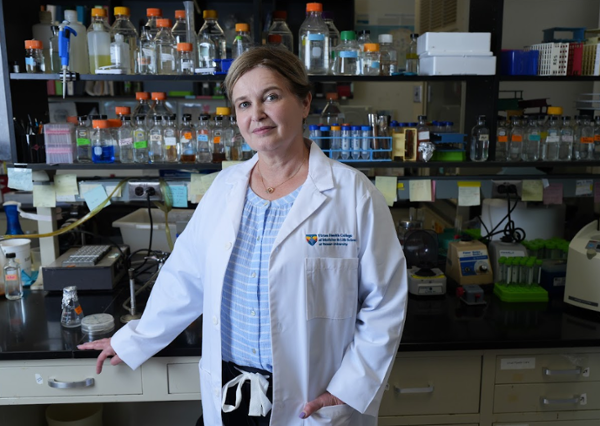Rowan researcher finds potential new player in neurodegenerative diseases
Rowan researcher finds potential new player in neurodegenerative diseases

Progressive neurological diseases such as Alzheimer’s, Parkinson’s, and Amyotrophic Lateral Sclerosis (ALS) share a classic biomarker: the aberrant buildup of misfolded proteins, including TDP-43, in the cytoplasm of brain cells.
While researchers have long known that the accumulation of misfolded proteins, can lead to protein clumps, called aggregates, it remains unclear which molecular pathways promote their formation and which molecular mechanisms cause affected neurons to die.
Dr. Katrina Cooper, D. Phil., an associate professor of molecular biology in the Rowan-Virtua School of Translational Bioengineering Engineering & Sciences, part of the Virtua Health College of Medicine & Life Sciences, is investigating the role of another protein called cyclin C, which may significantly contribute to neuronal cell death in diseases triggered by the toxic buildup of TDP-43.
“Neurodegenerative diseases are associated with cell death,” Cooper explained. “Major questions include how and why cells die in response to accumulation of pathogenic protein aggregates. That’s what we want to understand.”
Cooper recently received a two-year, $424,450 grant from the National Institute on Aging, part of the National Institutes of Health, to support her study on the role of cyclin C in these diseases, which have no known cure. Her preliminary studies have shown that cyclin C, a conserved protein that usually resides in the nucleus, another cellular compartment, moves to the cytoplasm after stress, where it helps break apart mitochondria. This may promote cell death in neurodegenerative diseases that progressively accumulate clumps of TDP-43.
The World Health Organization predicts that as the population of people over the age of 65 doubles over the next three decades, the prevalence of neurodegenerative disorders will increase as well.
In the long term, Cooper hopes her study will illuminate how cyclin C impacts these progressive diseases and encourage more research to discover other proteins that may influence neurodegeneration. Her findings could potentially contribute to the development of new drugs to cure or slow the progression of disease.
“Everybody thought they knew all the proteins in TDP-43 biology,” Cooper said. “Here, we’ve discovered we have a new player—and there are potentially other new players which are still out there that we need to investigate.”